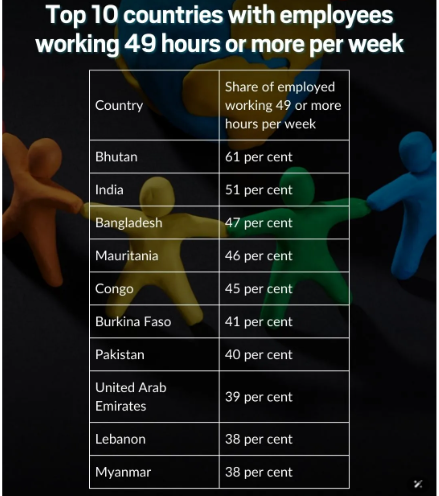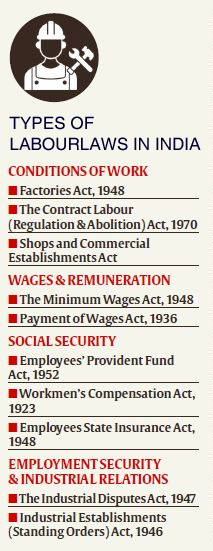Social Issues
Workplace Culture of India
- 06 Nov 2024
- 9 min read
For Prelims: ILO, Concurrent List, Code of Wages, 2019, Industrial Relations Code, 2020, Social Security Code, 2020, Occupational Safety, Health and Working Conditions Code, 2020
For Mains: India’s Corporate Culture: Regulatroty Framework, Recommendations and Challenges
Why in News?
The tragic case of Anna Sebastian, a chartered accountant who is reported to have died due to work-related stress, underscores the urgent need to address the toxic workplace culture in India, highlighting the continued exploitation of workers.
Note:
- According to the recent study of International Labour Organisation, India ranks among the most overworked countries globally, with workers averaging 46.7 hours per week.
- Additionally, 51% of India's workforce clocks 49 or more hours weekly, placing the country second in terms of extended working hours worldwide.
What are the Key Issues in India’s Workplace Culture?
- Toxic Work Environment:
- Long working hours and stress have become normalised in many corporations, driven by a relentless focus on profit margins and bottom lines.
- The practice of overworking employees while cutting costs often leads to burnout, as companies justify exploitation with terms like “organisational stretch” and “variable pay.”
- Responses to Work Culture Issues:
- Corporate initiatives like codes of conduct and work-life balance policies often lack depth, failing to address the root causes of workplace toxicity effectively.
- Abusive Leadership and Lack of Accountability:
- The absence of legal recourse for employees facing workplace harassment or abusive language creates an environment where such behaviors can persist unchallenged.
- The performance evaluation systems in many companies are perceived as biased, leading to feelings of unfair treatment among employees, which breeds resentment and a toxic atmosphere.
- Public Sector vs. Private Sector Dynamics:
- Public sector organisations typically offer stronger job security and a more supportive work environment, aided by unions that help address employee grievances.
- This difference raises questions about the need for improved practices within the private sector to foster a healthier work culture.
- Public sector organisations typically offer stronger job security and a more supportive work environment, aided by unions that help address employee grievances.
- Fatalities Linked to Long Working Hours:
- In 2016, WHO and ILO estimated that long working hours contributed to 745,000 deaths due to stroke and ischemic heart disease—a 29% increase since 2000.
- Workers aged 60-79 who consistently worked more than 55 hours per week between ages 45 and 74 exhibited higher mortality rates.
- In 2016, WHO and ILO estimated that long working hours contributed to 745,000 deaths due to stroke and ischemic heart disease—a 29% increase since 2000.
- Link Between GDP and Working Hours:
- ILO reveals that countries with shorter working hours often enjoy higher per capita GDP. Nations like Norway (33.7 hours) and the Netherlands (31.6 hours) maintain shorter working weeks while prioritising worker well-being, which in turn boosts overall economic prosperity.
- In contrast, countries like India and Bhutan have longer working hours but lower per capita income, suggesting that long working hours don’t necessarily equate to economic success.
- ILO reveals that countries with shorter working hours often enjoy higher per capita GDP. Nations like Norway (33.7 hours) and the Netherlands (31.6 hours) maintain shorter working weeks while prioritising worker well-being, which in turn boosts overall economic prosperity.
Workplace Culture in Other Countries
- United States:
- Demanding work culture with long hours, but increasing flexibility (remote work, flexible hours, etc.).
- Focus on performance with bonuses and stock options, but leads to competition and income inequality.
- Stronger legal protections, though labor laws vary by state and unions are weaker in some sectors.
- Europe:
- Strong emphasis on work-life balance with strict labor laws (e.g., 35-hour workweek in France).
- Respectful and collaborative corporate culture with greater employee protections.
- More equitable compensation and generous benefits; robust labor protections and strong unions.
What is the Regulatory Framework Regarding Labours in India?
- Constitutional Framework: Under the Constitution, Labour as a subject is in the Concurrent List and, therefore, both the Central and the State governments are competent to enact legislations subject to certain matters being reserved for the Centre.
- Judicial Interpretation: In the case of Randhir Singh vs Union of India,1982, the Supreme Court stated that “Even though the principle of ‘Equal pay for Equal work’ is not defined in the Constitution, it is a goal which is to be achieved through Articles 14, 16 and 39 (c).
- Article 14: It provides for equality before the law or equal protection of the laws within the territory of India.
- Article 16: It talks about the right of equal opportunity in the matters of public employment.
- Article 39(c): It specifies that the economic system should not result in the concentration of wealth and means of production to the detriment of the entire society.
- Legislative Framework: There have been several legislative and administrative initiatives taken by the government to improve working conditions and simplify labour laws. Most recent is the consolidated sets of 4 labour codes which are yet to be implemented.
- Labour Codes:
- The Factories Act, 1948:
- Daily hours under the Factories Act cannot exceed nine hours in any day, according to Section 54.
- Every worker is entitled to an interval break of at least half an hour and not more than 5 hours of work should pass before such interval.
- No worker under the Act shall be required to work for more than 48 hours in any week, according to Section 51.
- Daily hours under the Factories Act cannot exceed nine hours in any day, according to Section 54.
- The Minimum Wages Act, 1948:
- Wages paid for overtime must be double the actual rate for any hour, or part of an hour, of actual work undertaken in excess of the prescribed 9 hours or 48 hours per week.
What can be Done to Improve Work Culture in India?
- Regulatory Framework:
- To effectively address toxic workplace culture, a regulatory framework is necessary. This could involve mandating corporate boards to be accountable for workplace conditions and employee welfare.
- Establishing clear guidelines for employee treatment and performance evaluations can help mitigate abusive practices.
- Cultural Shift in Corporations:
- Companies should actively promote a culture of respect and fairness, where employee contributions are acknowledged and rewarded appropriately.
- Initiatives focused on improving work-life balance, alongside genuine engagement with employees, could help foster a healthier workplace environment.
- Awareness and Advocacy:
- Increased awareness and discourse on workplace culture issues can empower employees to voice their concerns and advocate for their rights.
- Learning from international standards where employees have the right to sue for mental stress could prompt similar protections in India.
- Corporate Social Responsibility (CSR):
- Corporations must integrate a commitment to improving workplace culture into their CSR strategies, recognizing that employee well-being is integral to long-term success.
|
Drishti Mains Question Q.Discuss the key issues surrounding workplace culture in India. What regulatory reforms are necessary to improve employee-employer relations? |






